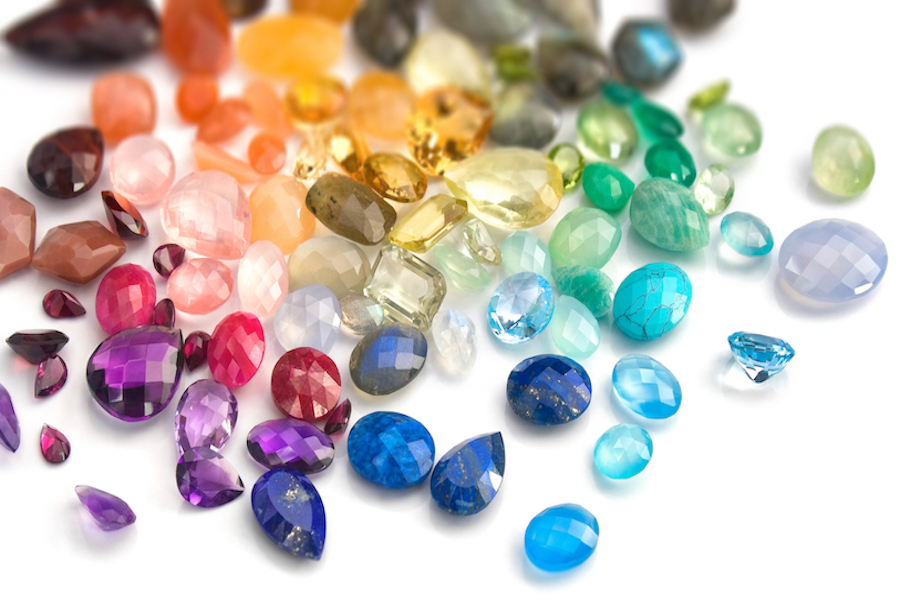
PRECIOUS STONES
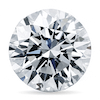
Diamond
Diamond is described extensively in the Diamonds section.
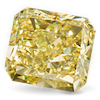
Fancy Colored Diamond
Fancy Colored Diamond is described extensively in the Fancy Colored Diamond section.
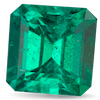
Emerald
Emerald is the green to a greenish-blue variety of the mineral Beryl, a mineral species that also includes the variety Aquamarine and others. Emerald is one of the most fascinating and beautiful gemstones. Its beautiful green color, combined with durability and rarity, makes it one of the most valuable gemstones. Deep green is the most desired color in emeralds. Flawless emerald stones are very uncommon and are noted for their high value, sometimes even more than diamonds. Emeralds that were treated to mask internal flaws should never be cleaned with an ultrasonic jewelry cleaner, nor should they be washed with soap. These practices will remove the oil and expose the hidden internal flaws. The name Emerald derives from the Greek 'Smaragdos' meaning 'Green Stone'. Emerald is the birthstone for May and the gem for the 20th and 35th anniversaries.
DOWNLOAD EMERALD
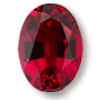
Ruby
Ruby is the red variety of the mineral Corundum, one of the hardest minerals on Earth, of which the Sapphire is also a variety. In its purest state, the mineral Corundum is actually colorless, colorless Sapphires were once popular diamond imitations. But colorless Corundum is rare, most Corundum contains trace elements that become part of the mineral’s crystal structure and cause variations in its color. When the trace elements are chromium, the corundum is red Ruby. Therefore only red corundum is entitled to be called Ruby, all other colors being classified as Sapphires. For thousands of years, the ruby has been considered one of the most valuable gemstones on Earth and is still today one of the most important gems in the colored stone market. It has everything a precious stone should have: outstanding brilliance, excellent hardness, durability, luster, rarity, and most important its magnificent color. The most prized tint is blood red or crimson known in the trade as 'pigeon's blood' red. Transparent rubies of large sizes are even rarer than diamonds. The name Ruby derives from Latin 'Rubens' meaning 'Red'. Ruby is the birthstone for July and the gem for the 15th and 40th anniversaries.
DOWNLOAD RUBY
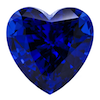
Sapphire
Sapphire is also a variety of the mineral Corundum and represents all the colors except red Corundum, which is Ruby. Its physical and chemical properties are virtually similar to the properties of Ruby. In its purest state, the mineral Corundum is actually colorless, colorless sapphires were once popular diamond imitations. But colorless Corundum is rare, most Corundum contains trace elements that become part of the mineral’s crystal structure and cause variations in its color. When the trace elements are iron and titanium, the corundum is blue Sapphire. Pure blue is the main color of the Sapphire, but it ranges from greenish blue to violetish blue. Besides blue Sapphire and red Ruby, the Corundum family also includes the 'Fancy Sapphires'. They come in colors like purple, orange, pink, gray, black, brown, green and colorless. Generally, the name 'Sapphire' in its plain context refers only to blue Sapphire unless a prefix color is specified. Sapphire is the most precious and desirable blue gemstone, due to its color, hardness, durability, and luster. Value of this gemstone depends on its size, color, and transparency. The Sapphire gemstone symbolizes harmony, friendship, and loyalty. Sapphire is the birthstone for September and the gem for the 5th and 45th anniversaries.
DOWNLOAD SAPPHIRE
SEMI-PRECIOUS STONES
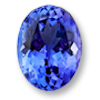
Alexandrite
Alexandrite is a variety of the mineral Chrysoberyl. The stone was discovered in 1830 in Russia and named after Czar Alexander II, who was then Crown Prince of Russia. Alexandrite is a very attractive and rare stone. Therefore, because of its scarcity, especially in larger sizes, it is among the most expensive gemstones in the world. The most impressive feature about this stone is its surprising ability to change its color under different forms of light. Its color can be a lovely green in daylight or fluorescent light, changing to brownish or purplish-red in the incandescent light from a lamp or candle flame. This color-change phenomenon is called “The Alexandrite Effect.” Alexandrite is the birthstone for June, along with Pearl and Moonstone, and the gem for the 55th wedding anniversary.
DOWNLOAD ALEXANDRITE

Amber
Amber is an organic gem. Organic gems are the products of living or once-living organisms and biological processes. Amber formed tens of millions of years ago when sap from ancient trees hardened and fossilized. Scientists and collectors treasure amber that contains suspended animal or plant fragments. These fossilized bits of once-living things were trapped in the hardening amber, creating a fascinating time capsule. Some types of amber are found in the ground. Other types have been freed and carried by tides, ending up on beaches or near-shore areas. The Baltic coast bordering Germany, Poland, and Russia is still an important source of amber. Amber is sometimes called “Gold of the North.” Its warm luster is featured in beads, carvings, pendants, and cabochons, as well as decorative items like cups, bowls, snuff boxes, and umbrella handles. While amber isn’t a birthstone, it is associated with the astrological sign of Taurus.

Amethyst
Amethyst is the purple variety of the mineral Quartz. This brilliantly sparkling stone is the most valued gemstone from the Quartz family. It’s the gem that’s most commonly associated with the color purple, even though there are other purple gems such as Sapphire and Tanzanite. Amethyst’s purple color can range from light lilac to a deep intense royal purple. Deeper-colored Amethysts are more highly valued. Amethyst also commonly shows what is called color zoning, which in the case of amethyst usually consists of angular zones of darker to a lighter color. This stone is said to bring good luck and to radiate love. The name Amethyst is derived from the Greek word 'Amethystos' meaning 'Not Intoxicated' or ‘Not Drunken’. Amethyst is the birthstone for February and the gem for the 6th and 17th wedding anniversaries.
DOWNLOAD AMETHYST
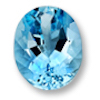
Aquamarine
Aquamarine is the green-blue to blue variety of Beryl, a mineral species that also includes the variety Emerald and others. This fascinatingly beautiful gemstone is found in colors like light blue of the sky to the deep blue of the sea. The more intense the color of an Aquamarine, the more value is put on it. Heat treatment usually gives it a more bluish appearance. Aquamarine crystals are known to be large in size and relatively clean and well-formed, making them particularly valuable to collectors of mineral specimens. Aquamarine is one of the most popular and best-known gemstones. The name Aquamarine is derived from the Latin 'Aqua' meaning 'Water' and 'Mare' meaning 'Sea'. Aquamarine is the birthstone for March and the gem of the 19th wedding anniversary.
DOWNLOAD AQUAMARINE
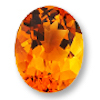
Citrine
Citrine is the pale yellow to brownish orange variety of the mineral Quartz. There are not many yellow gemstones in the world of jewels, and the Citrine fulfills everyone's color wishes in an affordable price range. The finest Citrine color is a saturated yellow to reddish-orange free of brownish tints. Since natural citrine is rare, most of the citrine on the market is the result of heat treatment, which causes some Amethyst to change color from undesirable pale violet to an attractive yellow. The Amethyst’s original hue can determine the richness of the resulting citrine’s yellow color. Citrine is known as a tough gemstone with good durability, it occurs in a wide range of sizes, and thus it is an excellent choice for everyday jewelry. The name Citrine is derived from the French word ‘Citrin’, meaning ‘Yellow’. Citrine is the birthstone for November along with Topaz, and the gem for the thirteenth anniversary.
DOWNLOAD CITRINE
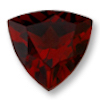
Garnet
Garnet is not a single mineral but describes a set of closely related minerals that form a group having many varieties differing in color and their constituents. They all have essentially the same crystal structure and physical properties but differ in chemical composition. Red is the most common color and widespread of Garnets, but not all Garnets are as abundant as the red ones, for instance, the rare green Tsavorite. Buyers can pick from a rich palette of colors like white, green, yellow, brown, and black. The name Garnet is derived from the Latin word “Garanatus,” meaning “Seedlike,” in reference to the resemblance in color and shape to the seeds of the pomegranate. Garnet is the birthstone for January and the gem for the 2nd anniversary.
DOWNLOAD GARNET
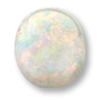
Opal
Opal is a very popular gemstone, mainly due to its wonderful variety of vibrant and beautiful colors. There are two classes of Opal: precious and common: precious Opal displays play-of-color (iridescence), while common Opal does not. One of the extraordinary features of this gemstone is called Opalescence, which is a kind of light play that happens with specific high-quality stones. Opals come in many attractive colors, including black, white, gray, yellow, colorless, orange and red, which is considered as the most popular and attractive color. Australia is the major supplier of fine Opals. Opal is made from sand and water, and therefore must be protected from harsh light and heat, which could dry it out and cause cracks. The name Opal is derived from three sources: Latin ‘Opalus’, Greek ‘Opallios’ and Sanskrit ‘Upala’, they all mean 'Precious stone.' Opal is the birthstone for October.
DOWNLOAD OPAL
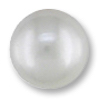
Pearl
Pearl is an organic gem, and perhaps the best-loved gem of all time. There are two types of Pearls: Natural Pearls and Cultured Pearls. Natural Pearls are formed organically when an irritant finds itself accidentally inside the oyster’s soft tissue muscle. This irritant, such as seawater sand or dust, activates the oyster’s defense mechanism, causing it to produce layers of nacre which slowly develops into a natural Pearl. Cultured Pearls are born through the very same process but require human intervention. Pearl farmers are physically inserting an irritant, such as a shell bead, inside the soft tissue of the oyster and returning it to the water. From there, the nacre-forming process begins and the layers of nacre are formed naturally, just like with natural pearls. There are four major types of Cultured Pearls: Akoya, South Sea, Tahitian, and Freshwater. Fine Natural Pearls are much more expensive and rare to find than Cultured Pearls. The most familiar Pearl colors are white and cream. However, black, gray, and silver are also fairly common, but the palette of Pearl colors extends to every hue. The main color, or body color, is often modified by additional colors, called overtones. Pearls are available in different shapes: round, semi-round, button, drop, pear, oval, baroque, and ringed. Perfectly round Pearls are the rarest and most expensive. A good-sized Pearl can take between five to eight years to form, which is usually the entire life of the oyster or mollusk. Pearl is a rare and living substance and should be treated with great care. Pearl is the birthstone for June along with Alexandrite and Moonstone, and the gem of the 3rd and 30th anniversaries.
DOWNLOAD PEARL
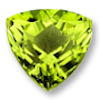
Peridot
Peridot is a variety of the mineral Olivine. The Peridot is an ancient but still very popular gemstone. It's chemical composition includes iron and magnesium, and iron is the cause of its attractive yellowish green colors. The gem often occurs in volcanic rocks called basalts, which are rich in these two elements. The color range for peridot is narrow, from a brown-green color to yellowish green to pure green. Yellowish green is the most common peridot color seen in jewelry. The name Peridot is derived from the Greek word ‘Peridona,’ meaning ‘Giving plenty.’ Peridot is the birthstone for August, along with Spinel, and the gem for the 15th anniversary.
DOWNLOAD PERIDOT
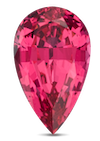
Spinel
Spinel, like garnet and diamond, is singly refractive, with the same physical properties in all crystal directions. The spinel used in jewelry is a small part of a group of minerals that share the same crystal structure. Not all of them form transparent crystals suitable for jewelry use, however. Spinel offers a range of hues, from orange to intense “stoplight” red, vibrant pink, and all shades of purple, blue, and violet through the bluish-green. Intense reds and pinks are caused by traces of chromium. The higher the chromium content, the stronger the red hue. Orange and purple stones owe their color to a mixture of iron and chromium. Violet to blue spinel can be colored by trace amounts of iron, and vibrant blues owe their saturated color to trace amounts of cobalt. Spinel is the birthstone for August, along with Peridot.
DOWNLOAD SPINEL
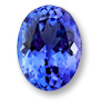
Tanzanite
Tanzanite is the violet-blue to a blue-violet variety of the mineral Zoisite. The stone was discovered in 1967 at Merelani Hills in Tanzania, which is the only place in the world where it is mined. Due to this reason, this stone is particularly highly prized. Tanzanite's appearance is influenced greatly by its pleochroism, which is the ability of a gemstone to show different colors when viewed in different crystal directions: red-violet, deep blue, and yellow-green. Today, most gems are heat-treated, which removes or reduces the yellow-green or brownish pleochroic color, maximizing the beautiful violet-blue color this stone is known for. Top-quality Tanzanite can be violetish blue, similar to a fine Sapphire color. Just like other colored gemstones, vivid strongly-colored Tanzanites are highly sought after. Tanzanite is a delicate gemstone and it should always be worn carefully. The name Tanzanite is derived from the East African state Tanzania where it was found. Tanzanite is the birthstone for December, along with Turquoise and the gem for the 24th anniversary.
DOWNLOAD TANZANITE
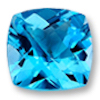
Topaz
Topaz is a variety of the mineral Quartz. Topaz is mostly known as simply an inexpensive blue gem. However, its vivid blue color is hardly ever natural, it’s almost always caused by treatment: exposed to heat. Topaz is allochromatic, which means that its color is caused by impurity elements or defects in its crystal structure rather than by an element of its basic chemical composition. The element chromium causes natural pink, red, and violet-to-purple colors in topaz. Imperfections at the atomic level in Topaz crystal structure can cause yellow, brown, and blue color. Brown is a common topaz color, and the gem is sometimes mistakenly called 'Smoky Quartz'. The color varieties are often identified simply by hue name: blue topaz, pink topaz, and so forth. Imperial topaz is a medium reddish-orange to orange-red, and one of the gem’s most expensive colors. Some stones are often called precious Topaz to help distinguish them from the similarly colored but less expensive Citrine and Smoky Quartz. Topaz is also pleochroic, meaning that the gem can show different colors in different crystal directions. Although Topaz is considered tough and durable gemstone but still it is not an invincible stone. It cracks and chips easily than many other gemstones, and should be treated with care. The name topaz is derived from the Sanskrit word ‘Tapas’, meaning ‘Fire’. Topaz is the birthstone for November and the gem for the 23rd anniversary.
DOWNLOAD TOPAZ
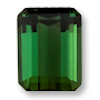
Tourmaline
Tourmaline has one of the broadest color ranges of any gem species, occurring in various shades of virtually every hue. Tourmalines are gemstones with deep brilliance and an incomparable variety of colors. Many Tourmaline color varieties have inspired their own trade names like Rubellite, Indicolite, Paraiba, Watermelon and more. The gemstone's chemical composition directly influences its physical properties and is responsible for its color. In the fascinating world of gemstones, the Tourmaline has a very special place. This gemstone has excellent wearing qualities and is easy to look after. The name Tourmaline is derived from the Singhalese words 'Tura Mali,' meaning something like 'Stone with mixed colors.' Tourmaline is the birthstone for October, along with Opal and the gem for the 8th anniversary.
DOWNLOAD TOURMALINE

Turquoise
Turquoise is an opaque mineral that occurs in beautiful hues of blue, bluish-green, green, and yellowish-green. Turquoise was one of the first gems to be mined and to be used for personal adornment. Turquoise is generally opaque, although you can find the rarer translucent Turquoise as well. Typically, the stone has a matte appearance and is not a sparkly gemstone. Most turquoise contain included matrix which refers to dark spidery inclusions, which can range from dense to light. The turquoise gemstone can be cut into many shapes, the most popular of which are cabochons, ovals, beads, and chips. Because turquoise is naturally very beautiful, cutting is not a critical factor to bring out its beauty. This gorgeous stone with its intriguing hue has the prestige of being the only gemstone with a color named after it. The name Turquoise is derived from the French word 'Pierre Turquoise', meaning 'Turkish Stone'. Because it was first transported to Europe via the Turkish nation. Turquoise is the birthstone for December and the gem of the 11th anniversary.
DOWNLOAD TURQUOISE